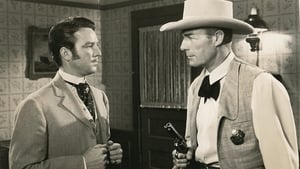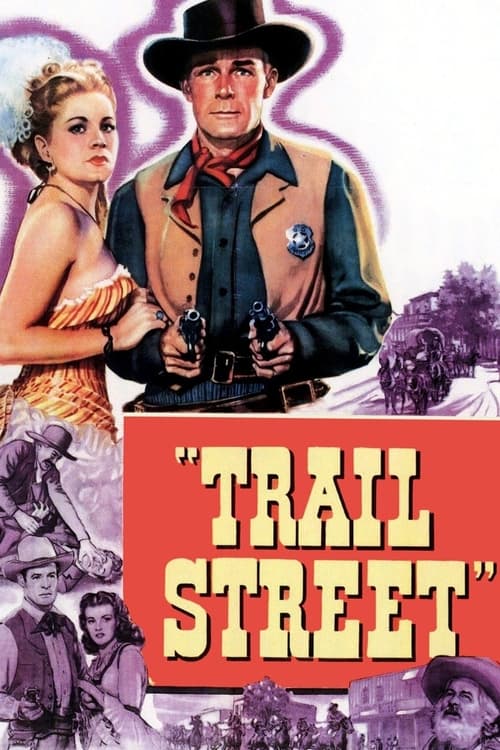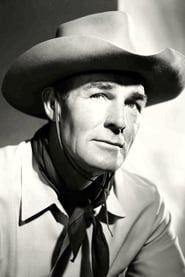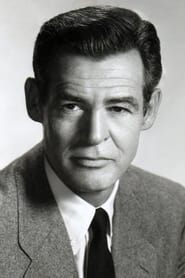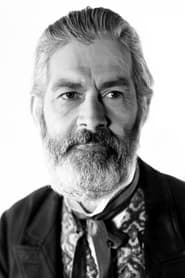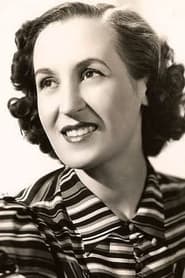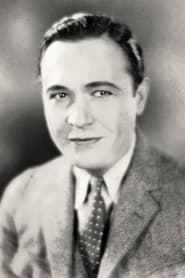Cast
View AllRandolph Scott
as Bat Masterson
Robert Ryan
as Allen Harper
Anne Jeffreys
as Ruby Stone
George 'Gabby' Hayes
as Billy Jones
Madge Meredith
as Susan Pritchett
Steve Brodie
as Logan Maury
Billy House
as Carmody
Virginia Sale
as Hannah
Harry Woods
as Larkin
Phil Warren
as Slim
Harry Harvey
as Mayor
Jason Robards Sr.
as Jason
Crew
Director
- Ray Enright
Producer
- Nat Holt
Reviews
John Chard
Every citizen is a peace officer when the peace is violated. This is a free country by statute.
Trail Street is directed by Ray Enright and adapted to screenplay by Norman Houston and Gene Lewis from the novel of the same name written by William Corcoran. It stars Randolph Scott, Robert Ryan, Anne Jeffreys, George Hayes, Madge Meredith and Steve Brodie. Music is by Paul Sawtell and cinematography by J. Roy Hunt.
Bat Masterson (Scott) is called to the town of Liberal in Kansas to act as Marshal because a range war has erupted.
It's the trail riders versus the farmers with Bat Masterson in the middle, perfect for Randy Scott then. Trail Street is a very honest Oater, sturdy of formula and played for genre compliant rewards. Clearly of no historical worth, mind, it's however a further reminder about one of the "names" that stand through the test of time from the Old West.The land war as a central plot device is always fascinating, for the two sides of the argument angle keeps things on the high heat. In the mix here comes corruption, romantic sub-plots (with 2 ladies of different social standings) and of course law and order as a force of nature.
Ultimately it's good fun entertainment, the cast themselves seemingly enjoying their respective parts and working for this director. Hayes brings the froth, Brodie the slimy menace, and the girls are not just token fodder. Scott isn't in it as much as we would like, but once arriving in town he dominates with genre gracefulness in what was soon to become his total career pathway. While Ryan is wonderfully fresh faced and lights up his scenes with distinction.
Enright has a good feel for character development, and when the pic begins to sag he pulls it back on track with a nifty action sequence. Rounding out the tech credits we have Hunt's (Crossfire) photography, which is spiffing and marries up smartly with the visual themes that Enright favours, while Sawtell keeps it safe and standard for aural pleasure. The ending is worth waiting for, with guns a toting and stunt men a falling from a high, and a very dark act is carried out to set us up for a boffo finale.
This is hardly a must see or must have in your Westerns collection, but it's above average and has an unassuming feel that's most pleasing for the genre faithful. 7/10
May 11, 2019
CinemaSerf
Liberal is a town in Kansas that is rapidly descending into lawlessness. That is until local "Billy Jones" (Gabby Hayes) gets his pal "Bat Masterson" (Randolph Scott), a federal marshal, to come and try to sort things out. With the help of "Harper" (Robert Ryan) and dancing girl "Ruby" (Anne Jeffreys) he sets his sights on "Maury" (Steve Brodie) and his manipulative henchman "Carmody" (Billy House). The only thing that distinguishes this from a whole slew of others of this type, is that Ryan manages to discover a wheat that is resistant to drought - a pretty perennial problem here - and that galvanises the farmers who are on the verge of giving up. Otherwise, it is a pretty routine adventure peppered with a few shoot-outs and a bit of romance. Scott and Ryan do their jobs OK, and the story moves along quickly enough but if you've seen one, then I'm afraid you've seen them all as far as this is concerned.
Jul 7, 2022
Thematic Analysis
Trail Street represents a fascinating example of Western cinema, offering viewers a unique perspective on the human experience and societal structures. The film's approach to its themes demonstrates a creative vision that distinguishes it within its genre.
Director Ray Enright brings their distinctive visual style to this film, continuing their exploration of themes seen in their previous works while adding new elements. Their approach to pacing and visual storytelling creates a viewing experience that rewards close attention.
Released in 1947, the film exists within a cultural context that now offers viewers historical perspective on the social issues of that era. Its reception demonstrates the diverse reactions to its artistic choices and its place in cinema history.
Did You Know?
- The production of Trail Street took approximately 12 months from pre-production to final cut.
- The final cut of the film runs for 84 minutes, though the director's initial assembly was reportedly 142 minutes long.
- Several scenes were filmed in multiple locations to capture the perfect setting.
- The cast underwent specialized training for 2 weeks before filming began.
- Some visual effects sequences took up to 10 months to complete.
Historical Context
- In 1947, when this film was released:
- Rock and roll music was revolutionizing popular culture.
- The civil rights movement was gaining momentum in the United States.
- The film industry was dominated by major studios, with independent cinema still in its early development.
How This Film Stands Out
While Trail Street shares thematic elements with other films in its genre, it distinguishes itself through its unique approach to storytelling, visual style, and character development.
Unlike Hang 'em High, which focuses more on action than character development, Trail Street subverts genre expectations by exploring its themes with greater nuance.
While films like The Night of the Grizzly and Rolling Down the Great Divide explore similar territory, Trail Street stands apart through its deeper exploration of its central themes and more complex characterization.
This film's unique contribution to cinema lies in its bold artistic choices and willingness to challenge viewer expectations, making it a valuable addition to its genre.
Details
- Release Date: February 19, 1947
- Runtime: 1h 24m
Where to Watch



